Drug-induced liver injury (DILI) is the most common cause of acute liver failure (ALF). Hepatotoxic drugs can cause dose-dependent, direct liver injury or idiosyncratic reactions mediated by immune or metabolic processes. This injury can result in hepatitis, cholestasis, steatosis, or overlapping changes. The presentation can be acute or chronic, with severe toxicity manifesting as fulminant liver failure. The diagnosis of DILI requires a thorough history, liver function tests, and drug levels, if available. Management consists of discontinuing the drug, supportive therapy, and monitoring for complications. Acetaminophen is the most common cause of DILI and is treated with a specific therapy, N-acetylcysteine (NAC).
Last updated: Mar 4, 2024
Liver Liver The liver is the largest gland in the human body. The liver is found in the superior right quadrant of the abdomen and weighs approximately 1.5 kilograms. Its main functions are detoxification, metabolism, nutrient storage (e.g., iron and vitamins), synthesis of coagulation factors, formation of bile, filtration, and storage of blood. Liver: Anatomy metabolism of drugs changes their biologic activity and makes them water-soluble for excretion in the urine and bile Bile An emulsifying agent produced in the liver and secreted into the duodenum. Its composition includes bile acids and salts; cholesterol; and electrolytes. It aids digestion of fats in the duodenum. Gallbladder and Biliary Tract: Anatomy.
Phase I reaction:
Phase II reaction:
Phase III reaction:
Intrinsic/direct hepatotoxins:
Idiosyncratic reactions:
Drugs can cause toxic effects by several mechanisms, resulting in mixed hepatocellular and cholestatic damage.
Potential mechanisms of how drugs cause liver Liver The liver is the largest gland in the human body. The liver is found in the superior right quadrant of the abdomen and weighs approximately 1.5 kilograms. Its main functions are detoxification, metabolism, nutrient storage (e.g., iron and vitamins), synthesis of coagulation factors, formation of bile, filtration, and storage of blood. Liver: Anatomy cell injury Cell injury The cell undergoes a variety of changes in response to injury, which may or may not lead to cell death. Injurious stimuli trigger the process of cellular adaptation, whereby cells respond to withstand the harmful changes in their environment. Overwhelmed adaptive mechanisms lead to cell injury. Mild stimuli produce reversible injury. If the stimulus is severe or persistent, injury becomes irreversible. Cell Injury and Death:
Potential mechanisms of how drugs affect the biliary excretion pathway:
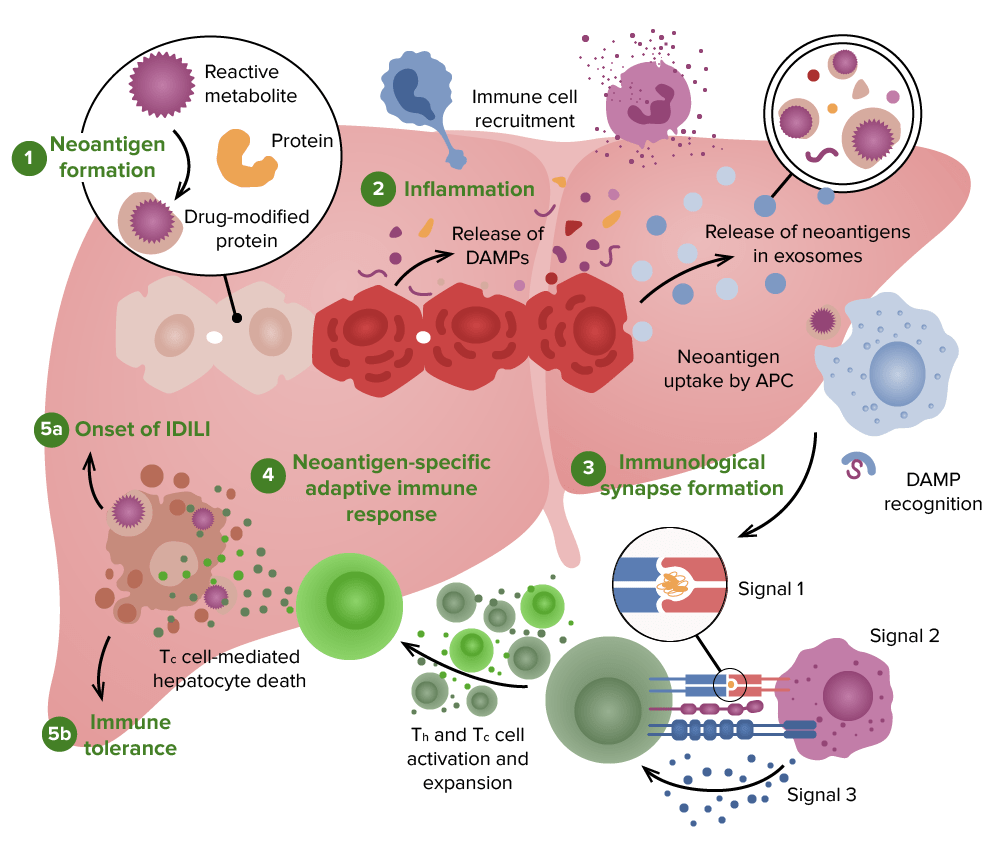
Possible pathophysiology of drug-induced liver injury:
1. A reactive metabolite may be formed by hepatocytes, which can covalently bond to proteins to form neoantigens.
2. A release of neoantigens and damage-associated molecular pattern (DAMP) molecules from damaged hepatocytes, which can lead to activation of antigen-presenting cells (APCs) and recruitment of innate immune cells.
3. APC activation leads to the expression of signal 1 and signal 2
4. T helper (Th) cells and cytotoxic T (Tc) cells are activated, leading to an adaptive immune response.
5. 5a: The dominant adaptive immune response in idiosyncratic drug-induced liver injury (IDILI) is usually a cell-mediated immune response.
5b: However, if the binding of the drug or drug-modified peptide is not very strong, the adaptive immune response will end in immune tolerance, preventing or limiting liver injury.
Acute liver failure Liver failure Severe inability of the liver to perform its normal metabolic functions, as evidenced by severe jaundice and abnormal serum levels of ammonia; bilirubin; alkaline phosphatase; aspartate aminotransferase; lactate dehydrogenases; and albumin/globulin ratio. Autoimmune Hepatitis:
Chronic liver Liver The liver is the largest gland in the human body. The liver is found in the superior right quadrant of the abdomen and weighs approximately 1.5 kilograms. Its main functions are detoxification, metabolism, nutrient storage (e.g., iron and vitamins), synthesis of coagulation factors, formation of bile, filtration, and storage of blood. Liver: Anatomy injury:
Diagnosing DILI can be difficult because it is a diagnosis of exclusion and the clinical picture can mimic other conditions. A thorough medical history (including medication) and thoughtful workup are necessary.
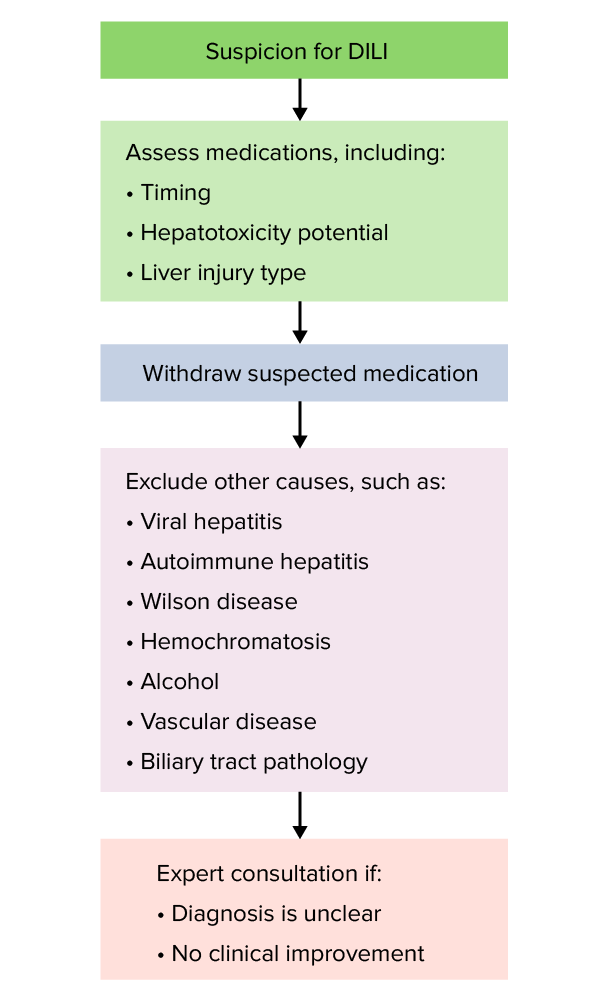
Simplified diagnostic flowchart for drug-induced liver injury (DILI)[1,4,10]
Image by Lecturio.Liver function tests Liver function tests Liver function tests, also known as hepatic function panels, are one of the most commonly performed screening blood tests. Such tests are also used to detect, evaluate, and monitor acute and chronic liver diseases. Liver Function Tests:[1,4,7,8,10,12]
| Type of injury | Blood test |
|---|---|
| Hepatitis |
|
| Cholestasis |
|
| Mixed |
|
Consider testing to exclude other suspected causes when clinically appropriate:[1,4,7,10,12]
Drug levels:[2]
Histologic patterns of injury:
| Pattern of injury | Examples |
|---|---|
| Acute hepatitis Acute Hepatitis Autoimmune Hepatitis |
|
| Chronic hepatitis/ fibrosis Fibrosis Any pathological condition where fibrous connective tissue invades any organ, usually as a consequence of inflammation or other injury. Bronchiolitis Obliterans |
|
| Cholestatic hepatitis Cholestatic Hepatitis Drug-Induced Liver Injury (mixed) |
|
| Cholestasis |
|
| Steatosis Steatosis Metabolic Dysfunction-associated Steatotic Liver Disease (MASLD) or steatohepatitis Steatohepatitis Drug-Induced Liver Injury |
|
| Granulomas Granulomas A relatively small nodular inflammatory lesion containing grouped mononuclear phagocytes, caused by infectious and noninfectious agents. Sarcoidosis |
|
| Vascular lesions |
|
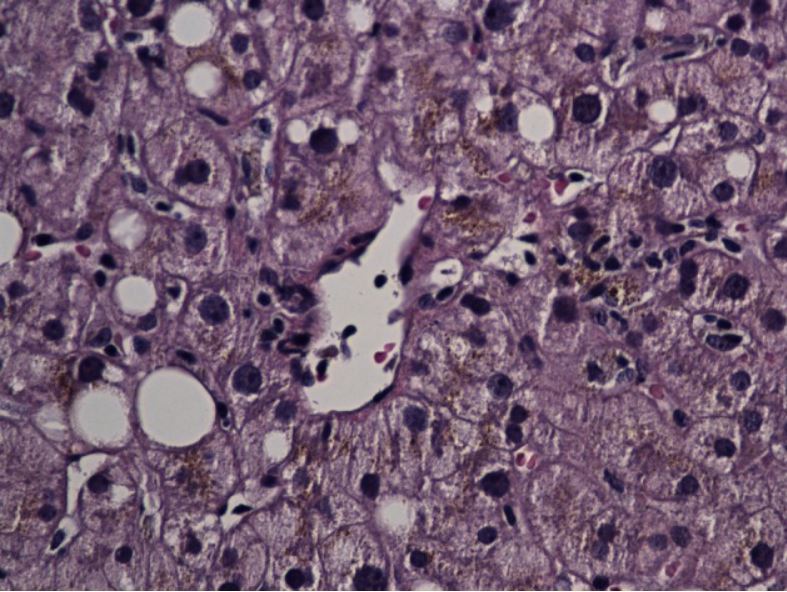
Liver biopsy specimen showing lobular hepatitis secondary to ibuprofen
Image: “A rare coexistence: drug-induced hepatitis and meningitis in association with Ibuprofen” by Nayudu SK, Kavuturu S, Niazi M, Daniel M, Dev A, Kumbum K. License: CC BY 2.0.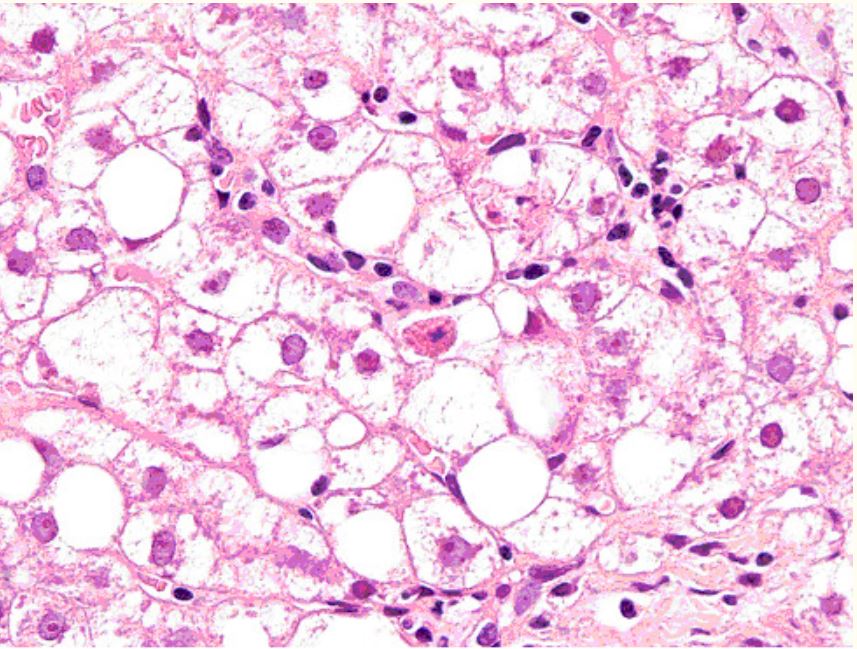
Liver biopsy of a patient with human immunodeficiency virus (HIV) infection taking stavudine
Laboratory tests showed elevated transaminases; image showed acidophil bodies, foamy degeneration of hepatocytes (steatosis).

Liver biopsy of a patient with elevated liver enzymes after treatment of Helicobacter pylori infection (using clarithromycin and amoxicillin):
Image shows portal inflammation.
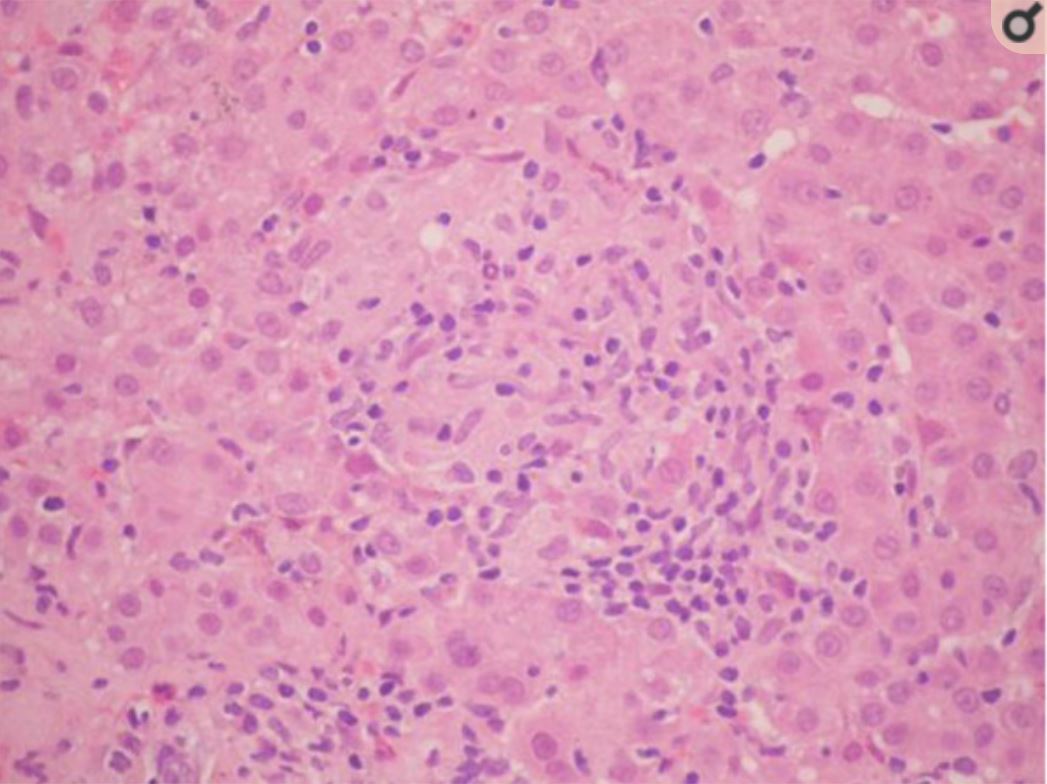
Image of albendazole-induced granulomatous hepatitis:
hepatic parenchyma with epithelioid macrophages that have formed granulomas without necrosis, interspersed with lymphocytes
The Roussel Uclaf Causality Causality Causality is a relationship between 2 events in which 1 event causes the other. Simply because relationships are observed between 2 variables (i.e., associations or correlations) does not imply that one variable actually caused the outcome. Demonstrating causality between an exposure and an outcome is the main objective of most published medical research. Causality, Validity, and Reliability Assessment Method (RUCAM) can be used as an objective evaluation of the likelihood for drug toxicity Toxicity Dosage Calculation:
Management may vary depending on practice location. The following information is based on US, UK, and European literature and guidelines.
There are limited specific treatments for DILI, which may include: